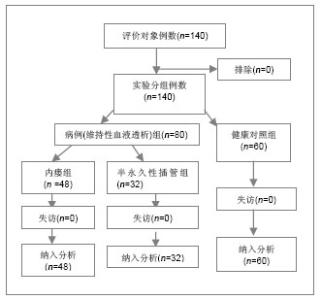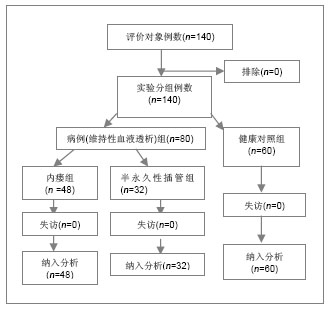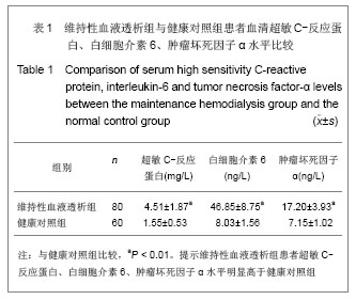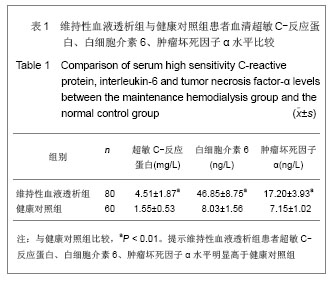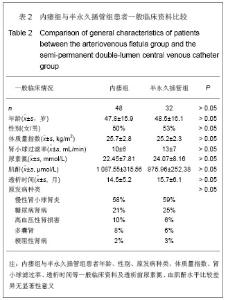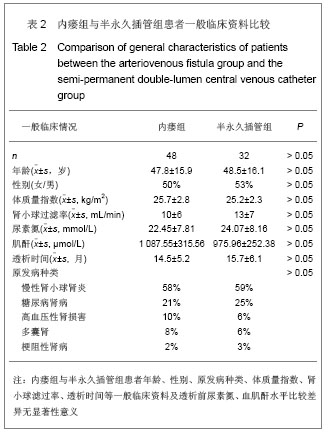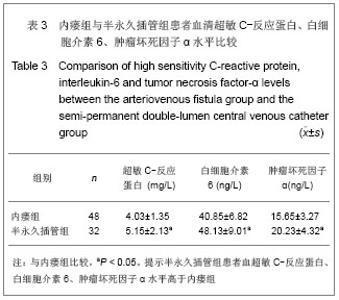| [1] Zuo L, Wang M. Zhongguo Xueye Jinghua. 2010;9(1): 41-49.左力, 王梅. 我国面临快速增长的终末期肾病治疗负担[J]. 中国血液净化, 2010,9(1): 41-49.[2] XiaoY, Sui BY, Zhao K. Zhongguo Weisheng Zhengce Yanjiu. 2011;4(5):29-33.肖月, 隋宾艳, 赵琨.我国终末期肾病现状及透析技术的应用、费用及支付情况分析[J].中国卫生政策研究,2011,4(5):29-33. [3] Qureshi AR,Alvestrand A,Divino-Filho JC,et al.Inflammation, malnutrition,and cardiac disease as predictors of mortality in hemodialysis patients.Am Soc Nephrol. 2002;13(1): 28-36. [4] Wang XH, Cui L, Cui Y, et al. Zhongguo Zuzhi Gongcheng Yanjiu yu Linchuang Kangfu. 2011;15(44):8317-8320.王祥花,崔莉,崔岩,等.血液透析患者社会回归及生活质量调查[J].中国组织工程研究与临床康复,2011,15(44):8317-8320.[5] Zhongguo Yiyuan Xiehui Xueye Jinghua Zhongxin Guanli Fenhui Xueye Touxi Dengjizu. Zhongguo Xueye Jinghua. 2010;9(1):47-49.中国医院协会血液净化中心管理分会血液透析登记组. 我国面临快速增长的终末期肾病治疗负担[J].中国血液净化,2010,9(1): 47-49.[6] Li H, Song J, Li Y, et al. Wujing Yixue. 2011;22(2):110-112.李辉,宋洁,李瑛,等.维持性血液透析患者炎性因子水平与左心室结构和功能的关系[J].武警医学,2011,22(2):110-112. [7] Moist LM, Trpeski L, Na Y, et al. Increased Hemodialysis Catheter Use in Canada and Associated Mortality Risk: Data from the Canadian Organ Replacement Registry 2001–2004. Clin J Am Soc Nephrol. 2008;3: 1726-1732. [8] Wang YZ. Zhongguo Xueye Jinghua. 2003;2(8):407-410.王玉柱. 血液透析血管通路进展[J].中国血液净化, 2003, 2(8):407-410.[9] Wang ZG. Beijing: Beijing Science and Technology Press. 2003. 王质刚. 血液净化学[M]. 北京:北京科学技术出版社, 2003.[10] Neyra NR, Ikizler TA, May RE, et al. Change in access blood flow over time predicts vascular access thrombosis. Kidney Int. 1998;54(5):1714-1719. [11] Chen XN, Xie JY, Zhu P, et al. Zhongguo Xueye Jinghua. 2009;8(7):362-364.陈晓农,谢静远,朱萍,等.不同血管通路血液透析患者透析充分性及并发症的比较[J].中国血液净化,2009,8(7):362-364.[12] Wang YZ. Beijing: People's Military Medical Press. 2008: 62-73. 王玉柱.血液净化通路[M].北京:人民军医出版社,2008:62-73.[13] Chen F, Fan Y, Liang L, et al. Zhongri Youhao Yiyuan Xuebao. 2010;24(1):55-56.陈枫,樊勇,梁莉,等.双腔带涤纶套长期留置管在血液透析中的应用[J].中日友好医院学报,2010,24(1):55-56.[14] Costa E, Lima M, Alves JM, et al. Inflammation, T-cell phenotype, and inflammatory cytokines in chronic kidney disease patients under hemodialysis and its relationship to resistance to recombinant human erythropoietin therapy. J Clin Immunol. 2008;28(3): 268-275.[15] Bi H, Zhang M, Zhang Y, et al. Zhongguo Zuzhi Gongcheng Yanjiu yu Linchuang Kangfu. 2010;14(25):4689-4692.毕会,张敏,张宇,等.高通量透析膜对C-反应蛋白及血脂代谢的影响[J].中国组织工程研究与临床康复,2010,14(25):4689-4692. [16] Wang SY, Long G. Guoji Yizhi yu Xueye Jinghua Zazhi. 2010; 8(2):30-31.王少艳,龙刚.超纯透析液对慢性血液透析患者C反应蛋白及促红细胞生成素反应性的影响[J]. 国际移植与血液净化杂志,2010, 8(2):30-31.[17] National Kidney Foundation. K/DOQI clinical practice guidelines for chronic kidney disease: evaluation, classification, and stratification. Am J Kidney Dis. 2002;39 (2 Supp l): 1-246. [18] Filiopoulos V, Vlassopoulos D. Inflammatory syndrome in chronic kidney disease: pathogenesis and influence on outcomes.Inflamm Allergy Drug Targets. 2009;8(5):369-382. [19] Wang Q, Zheng L, Zeng FY. Zhonghua Jianyan Yixue Zazhi. 2008;27(8):542-544.王前,郑磊,曾方银.超敏C反应蛋白的研究现状及临床应用[J].中华检验医学杂志,2008,27(8):542-544.[20] Li X, Peng LR. Zhongguo Xueye Jinghua. 2004;3(7):371.李新,彭立人.血液透析患者血清IL-6与急性时相反应的关系研究[J]. 中国血液净化,2004,3(7):371.[21] Wu A, Chen T, Feng SJ, et al. Zhongguo Zuzhi Gongcheng Yanjiu yu Linchuang Kangfu. 2007;11(21):4140-4143.吴瑗,陈婷,冯胜军,等. 晚期糖基化终产物对不同血液透析龄患者单核细胞分泌功能的影响[J].中国组织工程研究与临床康复, 2007,11(21):4140-4143.[22] Astor BC, Eustace JA, Powe NR, et al. Type of vascular access and survival amongincident hemodialysis patients: the choices for healthy outcomes in caring for ESRD (CHOICE) study. Clin J Am Soc Nephrol. 2005;16(5): 1449-1455. [23] Perl J, Wald R, McFarlane P, et al. Hemodialysis vascular access modifies the association between dialysis modality and survival. J Am Soc Nephrol. 2011;22(6): 1113-1121. [24] Yi LP, Zhang FY. Zhongguo Zuzhi Gongcheng Yanjiu yu Linchuang Kangfu. 2011;15(29):5421-5425.易丽萍,张悦凤.血液透析导管材料选择及感染的防治[J].中国组织工程研究与临床康复,2011,15(29):5421-5425.[25] Goldstein SL, Ikizler TA, Zappitelli M. Non-infected hemodialysis catheters are associated with increased inflammation compared to arteriovenous fistulas. Kidney Int. 2009;76(10):1063-1069. [26] Li JH, Xie XY, He CS. Shengwu Yixue Gongchengxue Zazhi. 2002;19(2):315-319.李洁华,谢兴益, 何成生.医用聚氨酯生物相容性研究新进展[J]. 生物医学工程学杂志, 2002,19(2):315-319.[27] Sachdeva M, Hung A, Kovalchuk O.The initial vascular access type contributes to inflammation in incident hemodialysis patients. Int J Nephrol. 2012;2012:917465. [28] Snaedal S, Heimbürger O, Qureshi AR, et al. Comorbidity and acute clinical events as determinants of C-reactive protein variation in hemodialysis patients: implications for patient survival. Am J Kidney Dis. 2009;53(6):1024-1033. |
